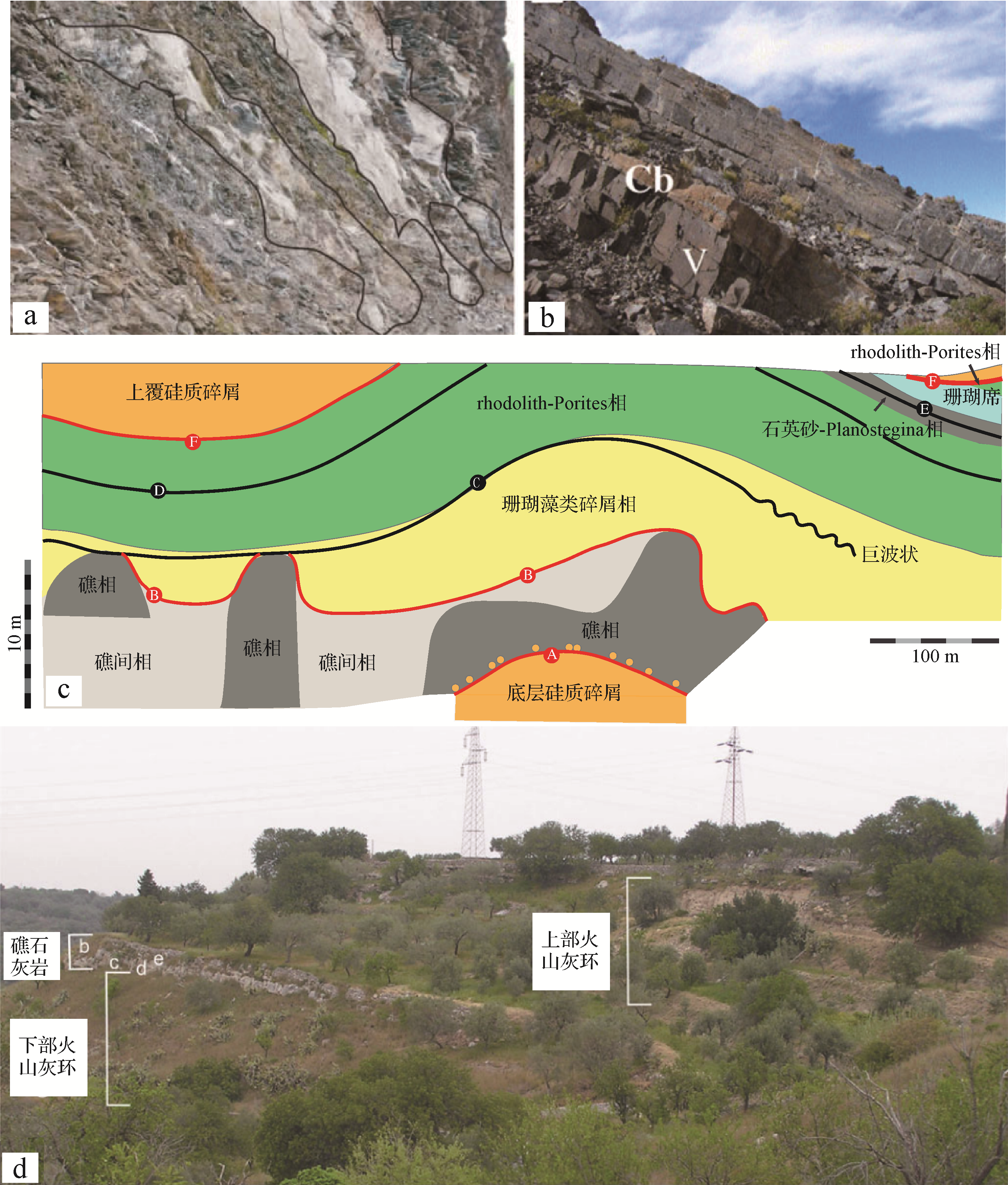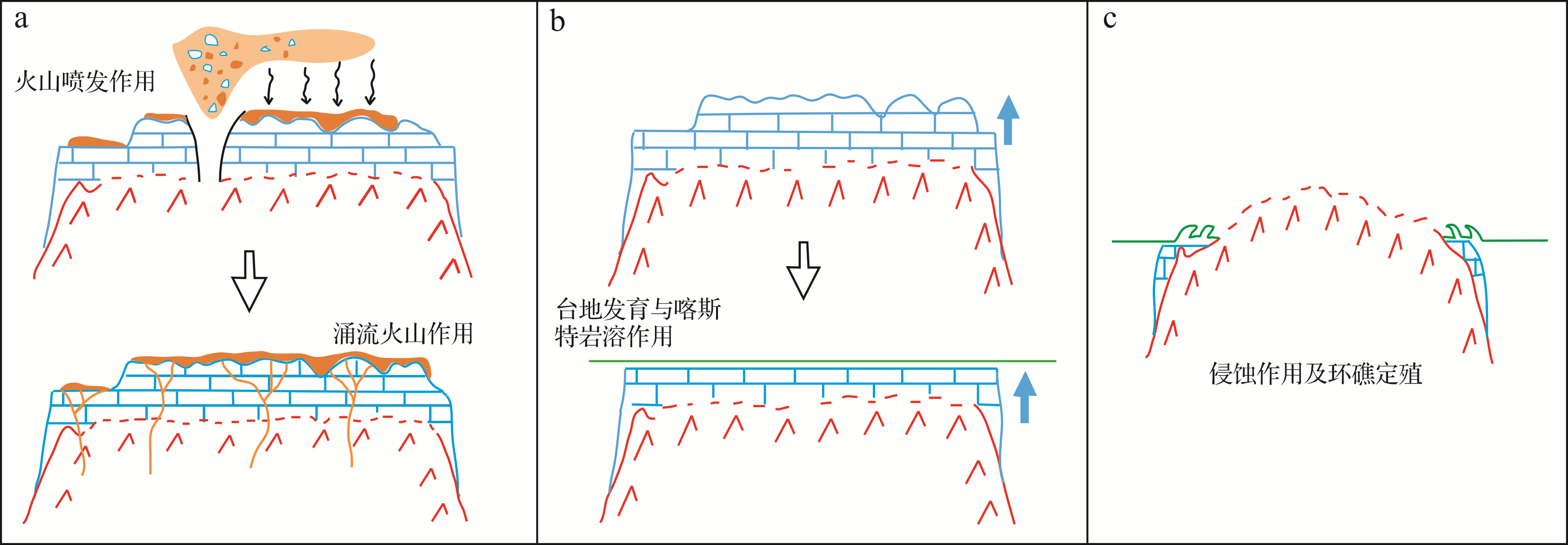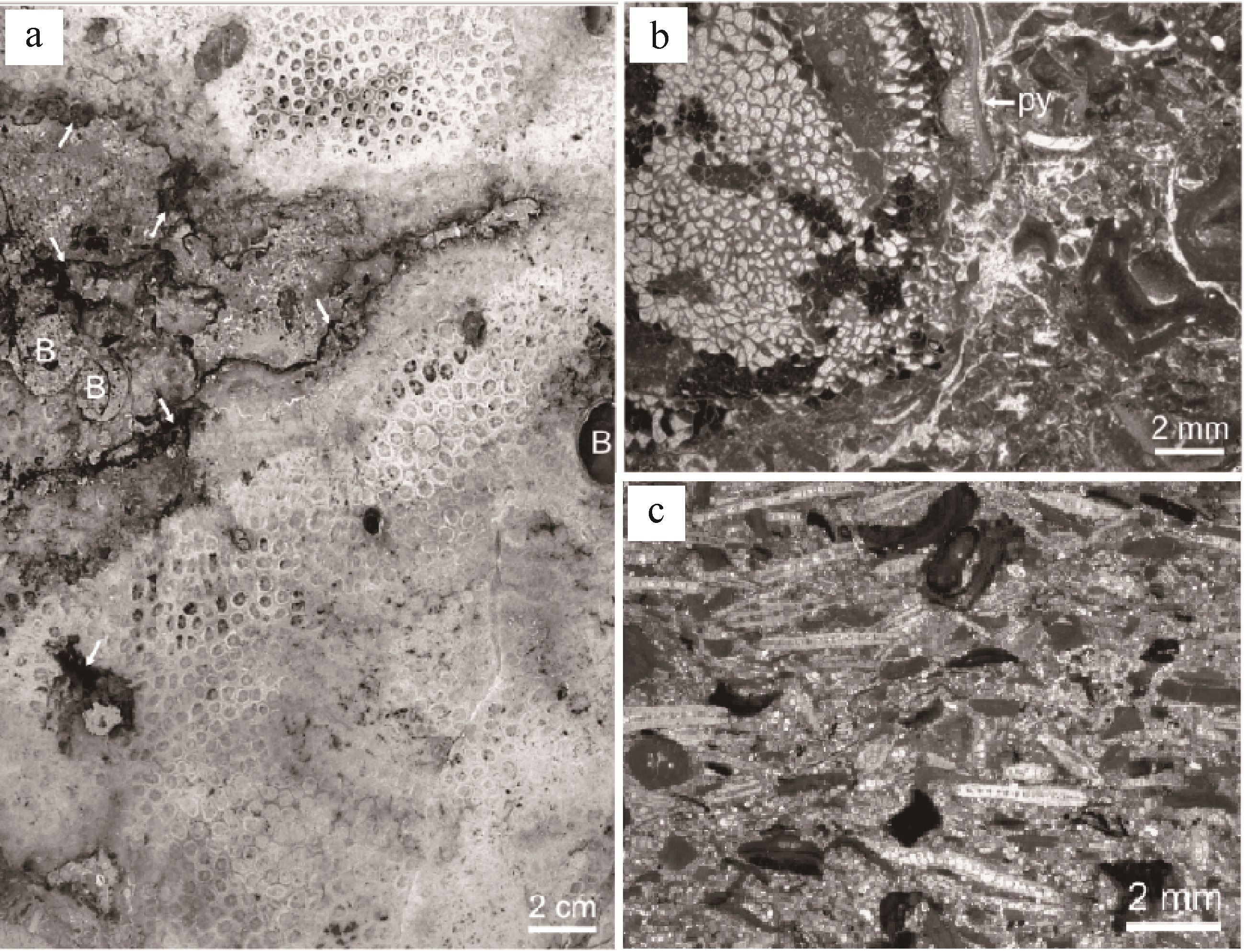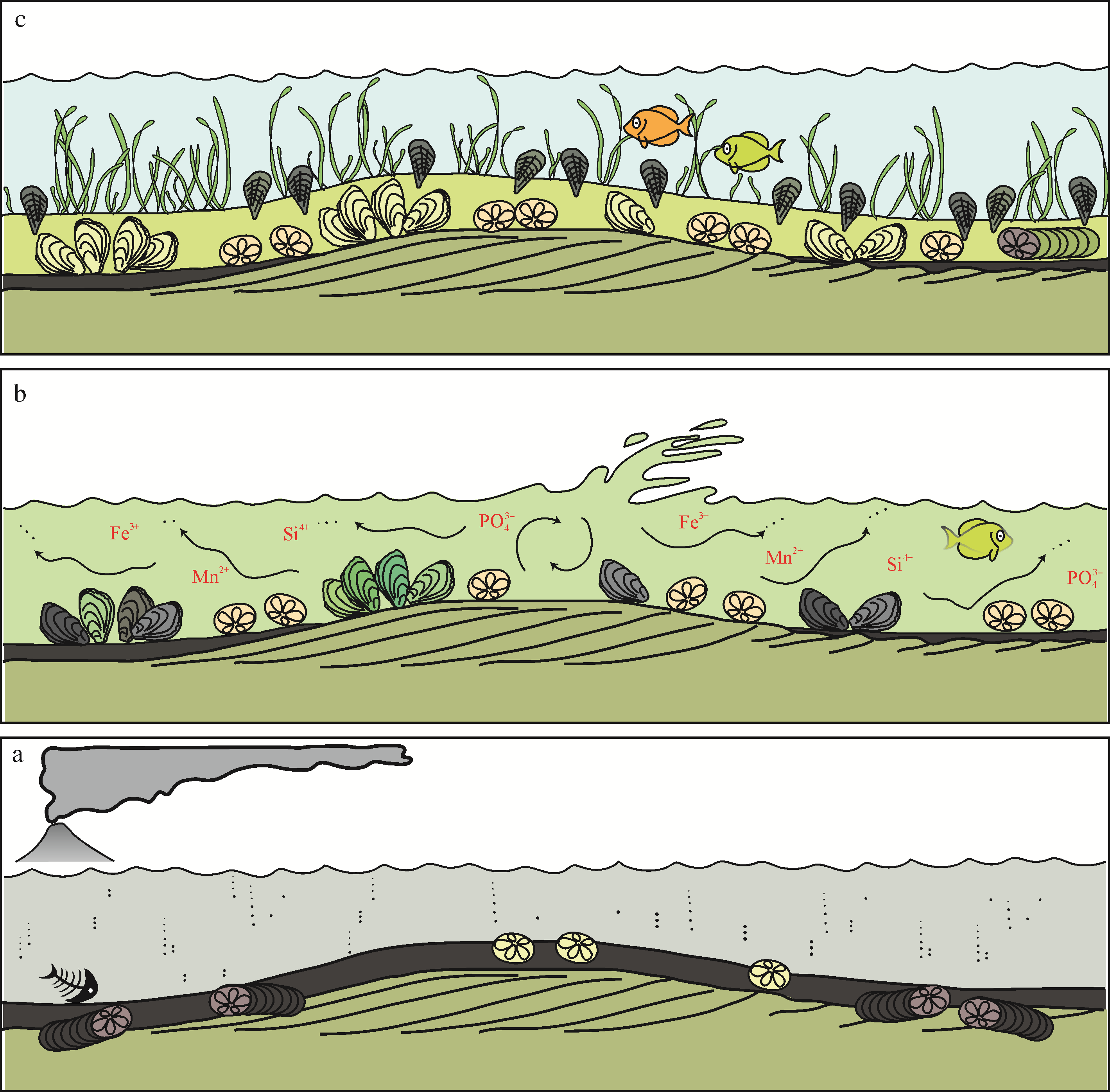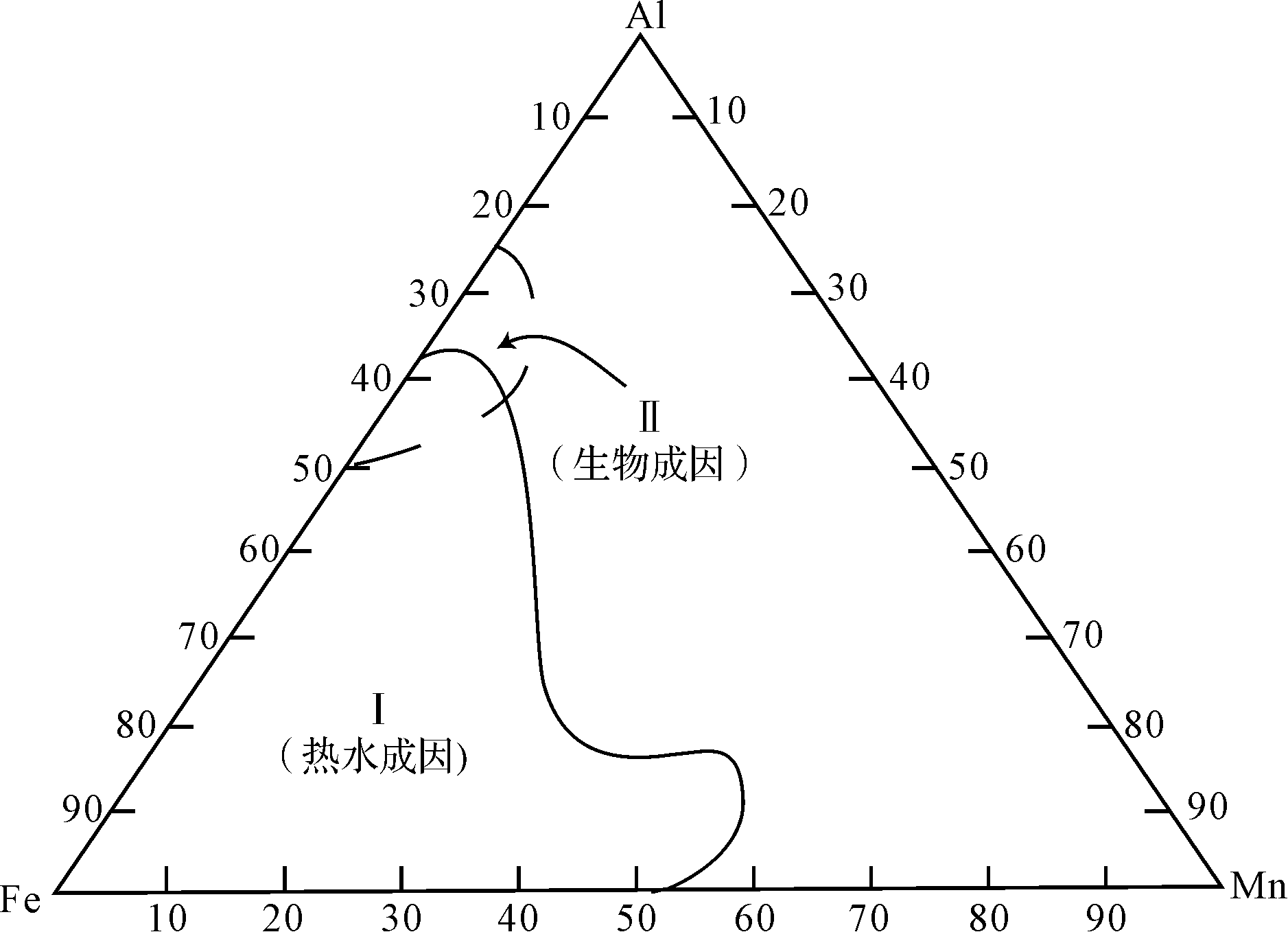| [1] |
徐夕生,邱检生. 火成岩岩石学[M]. 北京:科学出版社,2010. |
Xu Xisheng, Qiu Jiansheng. Igneous petrology[M]. Beijing: Science Press, 2010. |
| [2] |
王瑞华,谭钦银,付建元,等. 峨眉山地幔柱沉积—构造演化及沉积响应[J]. 地学前缘,2011,18(3):201-210. |
Wang Ruihua, Tan Qinyin, Fu Jianyuan, et al. The sedimentary-tectonic evolution and sedimentary response of mantle plume in Emeishan[J]. Earth Science Frontiers, 2011, 18(3): 201-210. |
| [3] |
Cen J, Xu Y G. Establishing the link between Permian volcanism and biodiversity changes: Insights from geochemical proxies[J]. Gondwana Research, 2019, 75: 68-96. |
| [4] |
Mircescu C V, Bucur I I, Săsăran E, et al. Facies evolution of the Jurassic-Cretaceous transition in the Eastern Getic Carbonate Platform, Romania: Integration of sequence stratigraphy, biostratigraphy and isotope stratigraphy[J]. Cretaceous Research, 2019, 99: 71-95. |
| [5] |
徐义刚,钟玉婷,位荀,等. 二叠纪地幔柱与地表系统演变[J]. 矿物岩石地球化学通报,2017,36(3):359-373. |
Xu Yigang, Zhong Yuting, Wei Xun, et al. Permian mantle plumes and earth's surface system evolution[J]. Bulletin of Mineralogy, Petrology and Geochemistry, 2017, 36(3): 359-373. |
| [6] |
Picotti V, Cobianchi M, Luciani V, et al. Change from rimmed to ramp platform forced by regional and global events in the Cretaceous of the Friuli-Adriatic Platform (southern Alps, Italy)[J]. Cretaceous Research, 2019, 104: 104⁃177. |
| [7] |
Vázquez-Loureiro D, Gonçalves V, Sáez A, et al. Diatom-inferred ecological responses of an oceanic lake system to volcanism and anthropogenic perturbations since 1290 CE[J]. Palaeogeography, Palaeoclimatology, Palaeoecology, 2019, 534: 109⁃285. |
| [8] |
Mambwe M P, Lavoie S, Delvaux D, et al. Soft sediment deformation structures in the Neoproterozoic Kansuki Formation (Katanga Supergroup, Democratic Republic of the Congo): Evidence for deposition in a tectonically active carbonate platform[J]. Journal of African Earth Sciences, 2019, 150: 86-95. |
| [9] |
Chen Z Q, Tu C Y, Pei Y, et al. Biosedimentological features of major microbe-metazoan transitions (MMTs) from Precambrian to Cenozoic[J]. Earth-Science Reviews, 2019, 189: 21-50. |
| [10] |
Zhu S F, Yue H, Zhu X M, et al. Dolomitization of felsic volcaniclastic rocks in continental strata: A study from the Lower Cretaceous of the A’nan Sag in Er’lian Basin, China[J]. Sedimentary Geology, 2017, 353: 13-27. |
| [11] |
Menezes C P, Bezerra F H R, Balsamo F, et al. Hydrothermal silicification along faults affecting carbonate-sandstone units and its impact on reservoir quality, Potiguar Basin, Brazil[J]. Marine and Petroleum Geology, 2019, 110: 198-217. |
| [12] |
Elias Bahnan A, Carpentier C, Pironon J, et al. Impact of geodynamics on fluid circulation and diagenesis of carbonate reservoirs in a foreland basin: Example of the Upper Lacq reservoir (Aquitaine Basin, SW France)[J]. Marine and Petroleum Geology, 2020, 111: 676-694. |
| [13] |
Chakir S, Slimani H, Hssaida T, et al. Dinoflagellate cyst evidence for the age, palaeoenvironment and paleoclimate of a new Cretaceous–Paleogene (K/Pg) boundary section at the Bou Angueur syncline, Middle Atlas, Morocco[J]. Cretaceous Research, 2020, 106: 104⁃219. |
| [14] |
Lima B E M, De Ros L F. Deposition, diagenetic and hydrothermal processes in the Aptian Pre-Salt lacustrine carbonate reservoirs of the northern Campos Basin, offshore Brazil[J]. Sedimentary Geology, 2019, 383: 55-81, |
| [15] |
Lukoczki G, Haas J, Gregg J M, et al. Multi-phase dolomitization and recrystallization of Middle Triassic shallow marine–peritidal carbonates from the Mecsek Mts. (SW Hungary), as inferred from petrography, carbon, oxygen, strontium and clumped isotope data[J]. Marine and Petroleum Geology, 2019, 101: 440-458. |
| [16] |
胡东风. 四川盆地元坝地区茅口组台缘浅滩天然气勘探的突破与启示[J]. 天然气工业,2019,39(3):1-10. |
Hu Dongfeng. Breakthrough in natural gas exploration in the platform margin shoal at the Maokou Fm in the Yuanba area, Sichuan Basin, and its implications[J]. Natural Gas Industry, 2019, 39(3): 1-10. |
| [17] |
Huang H, Cawood P A, Hou M C, et al. Provenance of Late Permian volcanic ash beds in South China: Implications for the age of Emeishan volcanism and its linkage to climate cooling[J]. Lithos, 2018, 314-315: 293-306. |
| [18] |
Xian B Z, He Y X, Niu H P, et al. Identification of hydrovolcanism and its significance for hydrocarbon reservoir assessment: A review[J]. Journal of Palaeogeography, 2018, 7(4): 348-362. |
| [19] |
徐伟,杜晓峰,黄晓波,等. 混合沉积研究进展与关键问题[J]. 沉积学报,2019,37(2):225-238. |
Xu Wei, Du Xiaofeng, Huang Xiaobo, et al. Research advances and critical issues of “mixed siliciclastic and carbonate sediments”[J]. Acta Sedimentologica Sinica, 2019, 37(2): 225-238. |
| [20] |
Martin U, Breitkreuz C, Egenhoff S, et al. Shallow-marine phreatomagmatic eruptions through a semi-solidified carbonate platform (ODP Leg 144, Site 878, Early Cretaceous, MIT Guyot, West Pacific)[J]. Marine Geology, 2004, 204(3/4): 251-272. |
| [21] |
Hannon J S, Huff W D. Assessing the preservation and provenance of Sr and Nd isotopic signatures in Cretaceous volcanic ash beds[J]. Lithos, 2019, 346-347: 105-145. |
| [22] |
郭俊锋,宋祖晨,肖良,等. 陕西汉中梁山二叠系乐平统底部吴家坪组王坡页岩新认识[J]. 地质论评,2017,63(5):1169-1179. |
Guo Junfeng, Song Zuchen, Xiao Liang, et al. New petrographic and mineralogical analyses of the Wangpo shale, Wujiaping Formation (Basal Lopingian, Permian) in the Liangshan area of Shaanxi[J]. Geological Review, 2017, 63(5): 1169-1179. |
| [23] |
Calarge L M, Meunier A, Formoso M L L. A bentonite bed in the Aceguá (RS, Brazil) and Melo (Uruguay) areas: A highly crystallized montmorillonite[J]. Journal of South American Earth Sciences, 2003, 16(2): 187-198. |
| [24] |
Fisher R V, Schmincke H U. Pyroclastic rocks[M]. Berlin: Springer-Verlag, 1984: 1-472. |
| [25] |
范广慧,王永标,孟峥,等. 贵州紫云晚二叠世:早三叠世初火山作用与生物礁的沉积演化[J]. 沉积学报,2017,35(1):24-34. |
Fan Guanghui, Wang Yongbiao, Meng Zheng, et al. The relationship between volcanism and reef sedimentary evolution from Late Permian to the beginning of Early Triassic in Ziyun area, Guizhou province[J]. Acta Sedimentologica Sinica, 2017, 35(1): 24-34. |
| [26] |
王璞珺,缴洋洋,杨凯凯,等. 准噶尔盆地火山岩分类研究与应用[J]. 吉林大学学报(地球科学版),2016,46(4):1056-1070. |
Wang Pujun, Jiao Yangyang, Yang Kaikai, et al. Classification of volcanogenic successions and its application to volcanic reservoir exploration in the Junggar Basin, NW China[J]. Journal of Jilin University (Earth Science Edition), 2016, 46(4): 1056-1070. |
| [27] |
Di Roberto A, Smedile A, Del Carlo P, et al. Tephra and cryptotephra in a ~ 60, 000-year-old lacustrine sequence from the Fucino Basin: New insights into the major explosive events in Italy[J]. Bulletin of Volcanology, 2018, 80(3): 20. |
| [28] |
Smith V C, Isaia R, Engwell S L, et al. Tephra dispersal during the Campanian Ignimbrite (Italy) eruption: Implications for ultra-distal ash transport during the large caldera-forming eruption[J]. Bulletin of Volcanology, 2016, 78(6): 45. |
| [29] |
McNamara K, Rust A C, Cashman K V, et al. Comparison of lake and land tephra records from the 2015 eruption of Calbuco volcano, Chile[J]. Bulletin of Volcanology, 2019, 81(2): 10. |
| [30] |
Obst K, Ansorge J, Matting S, et al. Early Eocene volcanic ashes on Greifswalder Oie and their depositional environment, with an overview of coeval ash-bearing deposits in northern Germany and Denmark[J]. International Journal of Earth Sciences, 2015, 104(8): 2179-2212. |
| [31] |
Reuter M, Piller W E, Erhart C. A Middle Miocene carbonate platform under silici-volcaniclastic sedimentation stress (Leitha Limestone, Styrian Basin, Austria)-Depositional environments, sedimentary evolution and palaeoecology[J]. Palaeogeography, Palaeoclimatology, Palaeoecology, 2012, 350-352: 198-211. |
| [32] |
Basile C, Chauvet F. Hydromagmatic eruption during the buildup of a Triassic carbonate platform (Oman Exotics): Eruptive style and associated deformations[J]. Journal of Volcanology and Geothermal Research, 2009, 183(1/2): 84-96. |
| [33] |
Chelaru R, Săsăran E, Tămaș T, et al. Middle Miocene carbonate facies with rhodoliths from the NW Transylvanian Basin (Vălenii Șomcutei Cave, Romania)[J]. Facies, 2019, 65(1): 4. |
| [34] |
杨朝青,沙庆安. 云南曲靖中泥盆统曲靖组的沉积环境:一种陆源碎屑与海相碳酸盐的混合沉积[J]. 沉积学报,1990,8(2):59-66. |
Yang Chaoqing, Sha Qing’an. Sedimentary environment of the middle Devonian Qujing Formation, Qujing, Yunnan province: A kind of mixing sedimentation of terrigenous clastics and carbonate[J]. Acta Sedimentologica Sinica, 1990, 8(2): 59-66. |
| [35] |
闫臻,王宗起,张英利,等. 北大巴山与志留纪火山作用相关的碳酸盐岩沉积学特征及形成环境[J]. 沉积学报,2011,29(1):31-40. |
Yan Zhen, Wang Zongqi, Zhang Yingli, et al. Sedimentary features and tectonic environments of silurian volcanic-related carbonates in the North Daba mountains[J]. Acta Sedimentologica Sinica, 2011, 29(1): 31-40. |
| [36] |
Busquets P, Méndez-Bedia I, Gallastegui G, et al. The relationship between carbonate facies, volcanic rocks and plant remains in a Late Palaeozoic lacustrine system (San Ignacio Fm, Frontal Cordillera, San Juan province, Argentina)[J]. International Journal of Earth Sciences, 2013, 102(5): 1271-1287. |
| [37] |
Armella C, Leanza H A, Corfu F. Synsedimentary ash rains and paleoenvironmental conditions during the deposition of the Chachil Formation (Pliensbachian) at its type locality, Neuquén Basin, Argentina[J]. Journal of South American Earth Sciences, 2016, 71: 82-95. |
| [38] |
Türk-Öz E, Özyurt M. Palaeoenvironment reconstruction and planktonic foraminiferal assemblages of Campanian (Cretaceous) carbonate succession, Çayırbağ area (Trabzon, NE Turkey)[J]. Carbonates and Evaporites, 2019, 34(2): 419-431. |
| [39] |
焦鑫,柳益群,杨晚,等. 水下火山喷发沉积特征研究进展[J]. 地球科学进展,2017,32(9):926-936. |
Jiao Xin, Liu Yiqun, Yang Wan, et al. Progress on sedimentation of subaqueous volcanic eruption[J]. Advances in Earth Science, 2017, 32(9): 926-936. |
| [40] |
赵省民,陈登超,邓坚. 内蒙古西部银根—额济纳旗地区石炭系—二叠系碳酸盐岩沉积模式及其石油地质意义[J]. 地质通报,2010,29(2/3):351-359. |
Zhao Xingmin, Chen Dengchao, Deng Jian. Depositional models of the Permo-Carboniferous carbonate rocks and their significance in Yingen-Ejinaqi area, Inner Mongolia, China[J]. Geological Bulletin of China, 2010, 29(2/3): 351-359. |
| [41] |
Suiting I, Schmincke H U. Iblean diatremes 3: Volcanic processes on a Miocene carbonate platform (Iblean Mountains, SE-Sicily): A comparison of deep vs. shallow marine eruptive processes[J]. Bulletin of Volcanology, 2012, 74(1): 207-230. |
| [42] |
Huang X, Aretz M, Zhang X H, et al. Upper Viséan coral biostrome in a volcanic-sedimentary setting from the eastern Tianshan, Northwest China[J]. Palaeogeography, Palaeoclimatology, Palaeoecology, 2019, 531: 108-739. |
| [43] |
Caron V, Bailleul J, Chanier F, et al. Demise and recovery of Antillean shallow marine carbonate factories adjacent to active submarine volcanoes (Lutetian-Bartonian limestones, St. Bartholomew, French West Indies)[J]. Sedimentary Geology, 2019, 387: 104-125. |
| [44] |
Alexeiev D V, Biske Y S, Djenchuraeva A V, et al. Lower Moscovian Limestones of the Bogdashan range (NW China) as an indicator of cessation of arc magmatism in the Junggar region[J]. Stratigraphy and Geological Correlation, 2019, 27(1): 51-72. |
| [45] |
Engel B E. Effects of a shallow-water hydrothermal vent gradient on benthic calcifiers, Tutum Bay, Ambitle Island, Papua New Guinea[D]. South Florida: University of South Florida, 2010. |
| [46] |
Pandolfi J M, Tudhope A W, Burr G, et al. Mass mortality following disturbance in Holocene coral reefs from Papua New Guinea[J]. Geology, 2006, 34(11): 949-952. |
| [47] |
Dobretsov N L, Buslov M M, Yu U. Fragments of oceanic islands in accretion–collision areas of Gorny Altai and Salair, southern Siberia, Russia: Early stages of continental crustal growth of the Siberian continent in Vendian–Early Cambrian time[J]. Journal of Asian Earth Sciences, 2004, 23(5): 673-690. |
| [48] |
向忠金,闫全人,闫臻,等. 北大巴山志留系滔河口组火山碎屑岩相序、组构特征及古火山作用环境分析[J]. 地质学报,2010,84(3):311-328. |
Xiang Zhongjin, Yan Quanren, Yan Zhen, et al. Facies succession and architecture of Volcaniclastic rocks of the Taohekou Formation: Implication for Early Silurian volcanism in the North Dabashan area, China[J]. Acta Geologica Sinica, 2010, 84(3): 311-328. |
| [49] |
Hernández P A, Padilla G, Barrancos J, et al. Geochemical evidences of seismo-volcanic unrests at the NW rift zone of Tenerife, Canary Islands, inferred from diffuse CO2 emission[J]. Bulletin of Volcanology, 2017, 79(4): 30. |
| [50] |
Robock A. Volcanic eruptions and climate[J]. Reviews of Geophysics, 2000, 38(2): 191-219. |
| [51] |
Self S, Schmidt A, Mather T A. characteristics Emplacement, scales time, and volcanic gas release rates of continental flood basalt eruptions on Earth[M]//Keller G, Kerr A C. Volcanism, impacts, and mass extinctions: Causes and effects. Boulder, America: Geological Society of America, 2014: 319-337. |
| [52] |
施泽进,张瑾,李文杰,等. 四川盆地Guadalupian统碳酸盐岩稀土元素和碳—锶同位素特征及地质意义[J]. 岩石学报,2019,35(4):1095-1106. |
Shi Zejin, Zhang Jin, Li Wenjie, et al. Characteristics of rare earth element and carbon-strontium isotope and their geological significance of Guadalupian carbonate in Sichuan Basin[J]. Acta Petrologica Sinica, 2019, 35(4): 1095-1106. |
| [53] |
赵文斌,郭正府,孙玉涛,等. 火山区CO2气体释放研究进展[J]. 矿物岩石地球化学通报,2018,37(4):601-620. |
Zhao Wenbin, Guo Zhengfu, Sun Yutao, et al. Advances of the research on CO2 degassing from volcanic fields[J]. Bulletin of Mineralogy, Petrology and Geochemistry, 2018, 37(4): 601-620. |
| [54] |
陈军,徐义刚. 二叠纪大火成岩省的环境与生物效应:进展与前瞻[J]. 矿物岩石地球化学通报,2017,36(3):374-393. |
Chen Jun, Xu Yigang. Permian large igneous provinces and their impact on paleoenvironment and biodiversity: Progresses and perspectives[J]. Bulletin of Mineralogy, Petrology and Geochemistry, 2017, 36(3): 374-393. |
| [55] |
Wignall P B. Large igneous provinces and mass extinctions[J]. Earth-Science Reviews, 2001, 53(1/2): 1-33. |
| [56] |
林良彪,陈洪德,朱利东. 川东地区吴家坪组层序—岩相古地理特征[J]. 油气地质与采收率,2009,16(6):42-45. |
Lin Liangbiao, Chen Hongde, Zhu Lidong. Sequence-based lithofacies and paleographic characteristics of Wujiaping Formation, eastern Sichuan Basin[J]. Petroleum Geology and Recovery Efficiency, 2009, 16(6): 42-45. |
| [57] |
Brandano M, Cornacchia I, Tomassetti L. Global versus regional influence on the carbonate factories of Oligo-Miocene carbonate platforms in the Mediterranean area[J]. Marine and Petroleum Geology, 2017, 87: 188-202. |
| [58] |
马本俊. 南海北部不同背景下深水斜坡沉积体系特征及其演化模式[D]. 北京:中国科学院大学(中国科学院海洋研究所),2017. |
Ma Benjun. Characteristics and evolution model of deepwater slope system under different sedimentary settings in the continental margin of northern South China Sea[D]. Beijing: University of the Chinese Academy of Sciences (Institute of Oceanography, Chinese Academy of Sciences), 2017. |
| [59] |
马本俊,秦志亮,吴时国,等. 深水斜坡类型与沉积过程及其产物研究进展[J]. 沉积学报,2018,36(6):1075-1090. |
Ma Benjun, Qin Zhiliang, Wu Shiguo, et al. An overview of deep-water slope types and their corresponding sedimentary processes and productions[J]. Acta Sedimentologica Sinica, 2018, 36(6): 1075-1090. |
| [60] |
R J Alderson Stanton,. Limestone interbedded with submarine volcanics: The Early-Middle Miocene Conejo Volcanics, California[J]. Facies, 2013, 59(3): 467-480. |
| [61] |
Shahzad K, Betzler C, Ahmed N, et al. Growth and demise of a Paleogene isolated carbonate platform of the offshore Indus Basin, Pakistan: Effects of regional and local controlling factors[J]. International Journal of Earth Sciences, 2018, 107(2): 481-504. |
| [62] |
傅恒,曾驿,周小康,等. 珠江口盆地新生代碳酸盐岩形成地质条件[J]. 地质学报,2018,92(11):2349-2358. |
Fu Heng, Zeng Yi, Zhou Xiaokang, et al. Geological conditions of formation of Cenozoic carbonate rocks in the Pearl River Mouth Basin[J]. Acta Geologica Sinica, 2018, 92(11): 2349-2358. |
| [63] |
Mikołajewski Z, Grelowski C, Kwolek K, et al. Hydrocarbon habitat in the Zielin Late Permian isolated carbonate platform, western Poland[J]. Facies, 2019, 65(1): 2. |
| [64] |
顾家裕,马锋,季丽丹. 碳酸盐岩台地类型、特征及主控因素[J]. 古地理学报,2009,11(1):21-27. |
Gu Jiayu, Ma Feng, Ji Lidan. Types, characteristics and main controlling factors of carbonate platform[J]. Journal of Palaeogeography, 2009, 11(1): 21-27. |
| [65] |
Courgeon S, Jorry S J, Jouet G, et al. Impact of tectonic and volcanism on the Neogene evolution of isolated carbonate platforms (SW Indian Ocean)[J]. Sedimentary Geology, 2017, 355: 114-131. |
| [66] |
Courgeon S, Jorry S J, Camoin G F, et al. Growth and demise of Cenozoic isolated carbonate platforms: New insights from the Mozambique Channel seamounts (SW Indian Ocean)[J]. Marine Geology, 2016, 380: 90-105. |
| [67] |
Roche A, Vennin E, Bouton A, et al. Oligo-Miocene lacustrine microbial and metazoan buildups from the Limagne Basin (French Massif Central)[J]. Palaeogeography, Palaeoclimatology, Palaeoecology, 2018, 504: 34-59. |
| [68] |
曲长胜,邱隆伟,杨勇强,等. 吉木萨尔凹陷芦草沟组碳酸盐岩碳氧同位素特征及其古湖泊学意义[J]. 地质学报,2017,91(3):605-616. |
Qu Changsheng, Qiu Longwei, Yang Yongqiang, et al. Carbon and oxygen isotope compositions of carbonatic rock from Permian Lucaogou Formation in the Jimsar Sag, NW China and their paleolimnological significance[J]. Acta Geologica Sinica, 2017, 91(3): 605-616. |
| [69] |
张帅,柳益群,焦鑫,等. 准噶尔盆地吉木萨尔凹陷中二叠统芦草沟组云质岩沉积环境及白云石成因探讨[J]. 古地理学报,2018,20(1):33-48. |
Zhang Shuai, Liu Yiqun, Jiao Xin, et al. Sedimentary environment and formation mechanisim of dolomitic rocks in the Middle Permian Lucaogou Formation, Jimusar Depression, Junggar Basin[J]. Journal of Palaeogeography, 2018, 20(1): 33-48. |
| [70] |
余宽宏,操应长,邱隆伟,等. 准噶尔盆地玛湖凹陷早二叠世风城组沉积时期古湖盆卤水演化及碳酸盐矿物形成机理[J]. 天然气地球科学,2016,27(7):1248-1263. |
Yu Kuanhong, Cao Yingchang, Qiu Longwei, et al. Brine evolution of ancient lake and mechanism of carbonate minerals during the sedimentation of Early Permian Fengcheng Formation in Mahu Depression, Junggar Basin, China[J]. Natural Gas Geoscience, 2016, 27(7): 1248-1263. |
| [71] |
Ross K A, Schmid M, Ogorka S, et al. The history of subaquatic volcanism recorded in the sediments of Lake Kivu; East Africa[J]. Journal of Paleolimnology, 2015, 54(1): 137-152. |
| [72] |
Hickson T A, Theissen K M, Lamb M A, et al. Lower Pahranagat Lake: Modern analogue for extensive carbonate deposition in paleolakes of the Late Oligocene to Miocene Rainbow Gardens and Horse Spring Formations[J]. Journal of Paleolimnology, 2018, 59(1): 39-57. |
| [73] |
胡东平. 晚奥陶—早志留世海洋的碳、硫、锶和汞循环[D]. 合肥:中国科学技术大学,2017. |
Hu Dongping. C, S, Sr, and Hg cycles in the Late Ordovician-Early Silurian Oceans[D]. Hefei: University of Science and Technology of China, 2017. |
| [74] |
Roth R, Joos F. Model limits on the role of volcanic carbon emissions in regulating glacial–interglacial CO2 variations[J]. Earth and Planetary Science Letters, 2012, 329-330: 141-149. |
| [75] |
Noone K J, Sumaila U R, Diaz R J. Managing ocean environments in a changing climate[M]. Boston: Elsevier, 2013. |
| [76] |
Agostini S, Harvey B P, Wada S, et al. Ocean acidification drives community shifts towards simplified non-calcified habitats in a subtropical-temperate transition zone[J]. Scientific Reports, 2018, 8(1): 11354. |
| [77] |
Hall-Spencer J M, Rodolfo-Metalpa R, Martin S, et al. Volcanic carbon dioxide vents show ecosystem effects of ocean acidification[J]. Nature, 2008, 454(7200): 96-99. |
| [78] |
Martin S, Rodolfo-Metalpa R, Ransome E, et al. Effects of naturally acidified seawater on seagrass calcareous epibionts[J]. Biology Letters, 2008, 4(6): 689-692. |
| [79] |
Cigliano M, Gambi M C, Rodolfo-Metalpa R, et al. Effects of ocean acidification on invertebrate settlement at volcanic CO2 vents[J]. Marine Biology, 2010, 157(11): 2489-2502. |
| [80] |
Raven J, Caldeira K, Elderfield H, et al. Ocean acidification due to increasing atmospheric carbon dioxide[R]. London, UK: The Royal Society, 2005,215: 1-60. |
| [81] |
Anthony K R N, Kline D I, Diaz-Pulido G, et al. Ocean acidification causes bleaching and productivity loss in coral reef builders[J]. Proceedings of the National Academy of Sciences of the United States of America, 2008, 105(45): 17442-17446. |
| [82] |
Meron D, Hazanov L, Fine M, et al. Effect of ocean acidification on the coral microbial community[M]//Rosenberg E, Gophna U. Beneficial microorganisms in multicellular life forms. Berlin, Heidelberg: Springer, 2012: 163-173. |
| [83] |
Bharatha Rathna P, Santhanam P. A study on the impact of acidification on the morphometry, photosynthesis, and biochemical composition of phytoplankton[M]//Santhanam P, Begum A, Pachiappan P. Basic and applied phytoplankton biology. Singapore: Springer, 2019: 239-249. |
| [84] |
Tribollet A, Chauvin A, Cuet P. Carbonate dissolution by reef microbial borers: A biogeological process producing alkalinity under different pCO2 conditions[J]. Facies, 2019, 65(2): 9. |
| [85] |
Ayris P M, Delmelle P. The immediate environmental effects of tephra emission[J]. Bulletin of Volcanology, 2012, 74(9): 1905-1936. |
| [86] |
Reuter M, Piller W E. Volcaniclastic events in coral reef and seagrass environments: Evidence for disturbance and recovery (Middle Miocene, Styrian Basin, Austria)[J]. Coral Reefs, 2011, 30(4): 889-899. |
| [87] |
Fan G H, Wang Y B, Kershaw S, et al. Recurrent breakdown of Late Permian reef communities in response to episodic volcanic activities: Evidence from southern Guizhou in South China[J]. Facies, 2014, 60(2): 603-613. |
| [88] |
范广慧. 贵州紫云晚二叠世生物礁的演化及其对火山作用的响应[D]. 武汉:中国地质大学(武汉),2014. |
Fan Guanghui. Evolution of Late Permian reefs communities and its response to episodic volcanic activities-evidence from Ziyun in Guizhou province[D]. Wuhan: China University of Geosciences, Wuhan, 2014. |
| [89] |
Wilson M E J. Tectonic and volcanic influences on the development and Diachronous termination of a tertiary tropical carbonate platform[J]. Journal of Sedimentary Research, 2000, 70(2): 310-324. |
| [90] |
王振涛,周洪瑞,王训练,等. 鄂尔多斯盆地西、南缘奥陶纪地质事件群耦合作用[J]. 地质学报,2015,89(11):1990-2004. |
Wang Zhentao, Zhou Hongrui, Wang Xunlian, et al. Ordovician geological events group in the West and South Ordos Basin[J]. Acta Geologica Sinica, 2015, 89(11): 1990-2004. |
| [91] |
Duggen S, Olgun N, Croot P, et al. The role of airborne volcanic ash for the surface ocean biogeochemical iron-cycle: A review[J]. Biogeosciences, 2010, 7(3): 827-844. |
| [92] |
Olgun N, Duggen S, Croot P, et al. Surface ocean iron fertilization: The role of airborne volcanic ash from subduction zone and hot spot volcanoes and related iron fluxes into the Pacific Ocean[J]. Global Biogeochemical Cycles, 2011, 25(4): GB4001. |
| [93] |
Frogner P, Reynir Gíslason S, Óskarsson N. Fertilizing potential of volcanic ash in ocean surface water[J]. Geology, 2001, 29(6): 487-490. |
| [94] |
Yevenes M A, Lagos N A, Farías L, et al. Greenhouse gases, nutrients and the carbonate system in the Reloncaví Fjord (northern Chilean Patagonia): Implications on aquaculture of the mussel, Mytilus chilensis, during an episodic volcanic eruption[J]. Science of the Total Environment, 2019, 669: 49-61. |
| [95] |
Aref M A, Taj R J. Recent evaporite deposition associated with microbial mats, Al-Kharrar supratidal–intertidal sabkha, Rabigh area, Red Sea coastal plain of Saudi Arabia[J]. Facies, 2018, 64(4): 28. |
| [96] |
余聪,姚华舟,赵小明,等. 鄂西利川地区二叠—三叠系界线附近地层的碳酸盐微相类型和早三叠世火山活动的证据[J]. 华南地质与矿产,2015,31(2):115-124. |
Yu Cong, Yao Huazhou, Zhao Xiaoming, et al. Carbonate microfacies in strata near the Permian-Triassic boundary and the volcanic activity evidence in the Early Triassic in Lichuan area, western Hubei province[J]. Geology and Mineral Resources of South China, 2015, 31(2): 115-124. |
| [97] |
Tang H, Kershaw S, Liu H, et al. Permian–Triassic boundary microbialites (PTBMs) in Southwest China: Implications for paleoenvironment reconstruction[J]. Facies, 2017, 63(1): 2. |
| [98] |
Olivier N, Fara E, Vennin E, et al. Late Smithian microbial deposits and their lateral marine fossiliferous limestones (Early Triassic, Hurricane Cliffs, Utah, USA)[J]. Facies, 2018, 64(2): 13. |
| [99] |
Zhang W Y, Liu J, Dong Y, et al. Archaeal community structure in sediments from a seamount in the Mariana Volcanic Arc[J]. Journal of Oceanology and Limnology, 2019, 37(4): 1197-1210. |
| [100] |
Staudigel H, Clague D A. The geological history of deep-sea volcanoes: Biosphere, hydrosphere, and lithosphere interactions[J]. Oceanography, 2010, 23(1): 58-71. |
| [101] |
Vilaclara G, Martinez-Mekler G, Cuna E, et al. Diatom-inferred palaeoenvironmental changes of a Pliocene lake disturbed by volcanic activity[J]. Journal of Paleolimnology, 2010, 44(1): 203-215. |
| [102] |
Oelkers E H, Gislason S R, Matter J. Mineral carbonation of CO2[J]. Elements, 2008, 4(5): 333-337. |
| [103] |
周冰,朱德丰,李春柏,等. 海拉尔盆地贝尔凹陷含片钠铝石沉凝灰岩的成岩作用[J]. 沉积学报,2013,31(3):450-460. |
Zhou Bing, Zhu Defeng, Li Chunbai, et al. Diagenesis of dawsonite-bearing tuffite in Beier Sag, Hailar Basin[J]. Acta Sedimentologica Sinica, 2013, 31(3): 450-460. |
| [104] |
林良彪,陈洪德,朱利东. 重庆石柱吴家坪组硅质岩地球化学特征[J]. 矿物岩石,2010,30(3):52-58. |
Lin Liangbiao, Chen Hongde, Zhu Lidong. Geochemical characteristics of silicalites from Wujiaping Formation in Shizhu, Chongqing[J]. Journal of Mineralogy and Petrology, 2010, 30(3): 52-58. |
| [105] |
Adachi M, Yamamoto K, Sugisaki R. Hydrothermal chert and associated siliceous rocks from the northern Pacific their geological significance as indication of ocean ridge activity[J]. Sedimentary Geology, 1986, 47(1/2): 125-148. |
| [106] |
Qian M P, Xing G F, Ma X, et al. Mesoproterozoic stromatolites from Shennongjia UNESCO Global Geopark, central China[J]. Journal of Geology, 2018, 42(04): 527-542. |
| [107] |
Wang K Y, Fang A M, Zhang J, et al. Genetic relationship between fenitized ores and hosting dolomite carbonatite of the Bayan Obo REE deposit, Inner Mongolia, China[J]. Journal of Asian Earth Sciences, 2019, 174: 189-204. |
| [108] |
Cornacchia I, Agostini S, Brandano M. Miocene oceanographic evolution based on the Sr and Nd isotope record of the central mediterranean[J]. Paleoceanography and Paleoclimatology, 2018, 33(1): 31-47. |
| [109] |
Kocsis L, Vennemann T W, Fontignie D, et al. Oceanographic and climatic evolution of the Miocene Mediterranean deduced from Nd, Sr, C, and O isotope compositions of marine fossils and sediments[J]. Paleoceanography and Paleoclimatology, 2008, 23(4): PA4211. |
| [110] |
田景春,林小兵,郭维,等. 四川盆地二叠纪玄武岩喷发事件的油气地质意义[J]. 成都理工大学学报(自然科学版),2017,44(1):14-20. |
Tian Jingchun, Lin Xiaobing, Guo Wei, et al. Geological significance of oil and gas in the Permian basalt eruption event in Sichuan Basin, China[J]. Journal of Chengdu University of Technology (Science & Technology Edition), 2017, 44(1): 14-20. |
| [111] |
周新平,何幼斌,罗进雄,等. 川东地区二叠系结核状、条带状及团块状硅岩成因[J]. 古地理学报,2012,14(2):143-154. |
Zhou Xinping, He Youbin, Luo Jinxiong, et al. Origin of the Permian nodular, striped and lump siliceous rock in eastern Sichuan province[J]. Journal of Palaeogeography, 2012, 14(2): 143-154. |
| [112] |
周新平,何幼斌,杜红权,等. 四川宣汉地区二叠系硅岩地球化学特征及成因研究[J]. 古地理学报,2009,11(6):670-680. |
Zhou Xinping, He Youbin, Du Hongquan, et al. Geochemical characteristics and origin of the Permian siliceous rocksin Xuanhan region of Sichuan province[J]. Journal of Palaeogeography, 2009, 11(6): 670-680. |
| [113] |
金小燕,杜晓峰,王清斌,等. 渤海海域火山热流体及其对碳酸盐岩优质储层的控制作用[J]. 石油实验地质,2018,40(6):800-807,842. |
Jin Xiaoyan, Du Xiaofeng, Wang Qingbin, et al. Volcanic hydrothermal fluid activity and its influence on carbonate reservoirs in Bohai Sea area[J]. Petroleum Geology & Experiment, 2018, 40(6): 800-807, 842. |
| [114] |
金小燕,刘晓健,郝轶伟,等. CF油田火山热液流体活动及其对碳酸盐岩储层的改造作用[J]. 大庆石油地质与开发,2019,38(1):42-50. |
Jin Xiaoyan, Liu Xiaojian, Hao Yiwei, et al. Reformation of the volcanic hydrothermal fluid activities to the carbonate reservoir in CF oilfield[J]. Petroleum Geology and Oilfield Development in Daqing, 2019, 38(1): 42-50. |
| [115] |
吕修祥,解启来,杨宁,等. 塔里木盆地深部流体改造型碳酸盐岩油气聚集[J]. 科学通报,2007,52(增刊1):142-148. |
Xiuxiang Lü, Xie Qilai, Yang Ning, et al. Hydrocarbon accumulation in deep fluid modified carbonate rock in the Tarim Basin[J]. Chinese Science Bulletin, 2007, 52(Suppl.1): 142-148. |
















 DownLoad:
DownLoad:
